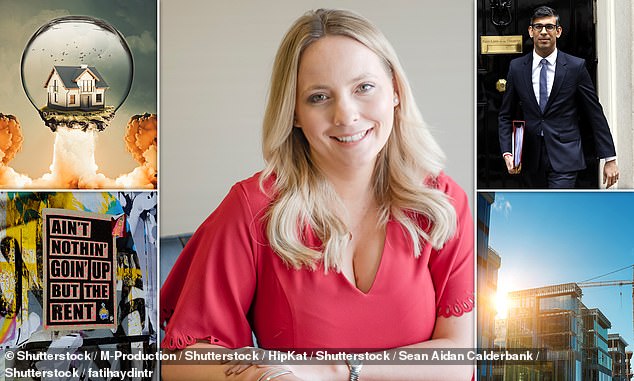Whether it’s unaffordable house prices, higher mortgage rates, soaring rents or increased levels of homelessness, the housing market appears to be stuck in a never-ending crisis.
There remains an insatiable appetite to buy property. Many of those who don’t own aspire to, and pour their life savings towards achieving it.
It is a dream that continues to move further out of reach for many, as the chronic under-supply of properties means house prices rise and rents increase.
As for those who already own, they tend to want more. Whether that means buying a bigger and better home, purchasing a holiday home or investing in buy-to-lets, the British obsession with acquiring property doesn’t stop at the first one.
Owning property has become synonymous with both wealth creation and wealth preservation and as the money keeps piling in, the prices keep going up.

Can you fix it? Each week we are speaking to a property expert about the housing crisis to find out their suggestions on how we might solve it
Government interventions often appear to add fuel to the fire. Stamp duty holidays, Help to Buy, Right to Buy and other schemes were meant to help more people on to the ladder.
But while many of those initiatives were successful, they also had the effect of pushing up house prices further for those that came after.
Worst of all, homelessness is rising. More than 300,000 people are recorded as homeless in England, according to research by the charity Shelter, with many in temporary accommodation.
In This is Money’s new series, we speak to a property expert every week to ask them what is wrong with Britain’s housing market – and how they would fix it.
This week, we spoke to Aneisha Beveridge, head of research at the estate agent Hamptons.
Does Britain have a housing crisis?
Aneisha Beveridge replies: A housing crisis means different things to different people. Regardless of age or situation, many people find themselves trapped paying over the odds for poor-quality accommodation. But today’s housing crisis has been felt most keenly by younger generations.
Anyone hitting adulthood since the 2007 crash is likely to be spending more on their home (in relative terms) than their parents did at the same age, often for a smaller place in a cheaper area.
This applies to both renters and homeowners. Millennials could be the first generation that find themselves worse off than their parents, not only in terms of their earning power, but also the home in which they live.

Expert: Aneisha Beveridge, head of research at Hamptons, says today’s housing crisis is ‘felt most keenly by younger generations’.
How does this compare to the past?
Home ownership peaked in 2003, when almost 71 per cent of households owned their home.
While owning a home isn’t the right choice for everyone, over the long term it provides a safety net – offering security of tenure as well as fixing monthly housing costs.
Over the lifetime of a mortgage, homeowners almost always find themselves better off, particularly as they get older when their income tends to fall.
Since 2007 an extra 3.2million households call England home. However, the number with a mortgage has fallen by just over a million over the same period.
Many of those mortgaged households have paid it off, but they haven’t been replaced by the next generation of homeowners.
Instead, more of these new households have grown up in the private rented sector which has more than doubled in size over the last 20 years.
Instead of being a stopgap for twenty and thirty-somethings, renting is becoming a tenure for life.
As house prices and, more recently, rents have risen faster than earnings, it’s become progressively harder for tenants to leave.
What was the biggest cause of the housing crisis?
Owners and tenants across the country have been spending an increasingly large chunk of their incomes on housing – money that could be spent elsewhere in the economy.
This is particularly true in London and the South East, where house prices and rents have become more detached from local incomes.
It’s here where the number of homes built has fallen furthest behind the number of newly formed households.
Demand here reflects the growing share of economic growth, which has sucked in people from across the UK and beyond.
Consequently, locals, particularly those on lower incomes, face tough competition from higher earners both nationally and internationally.
For lower earners and the young, this has been compounded by a lack of new affordable housing.
There are the same number of social homes today as there were 23 years ago. This means that the safety net has become increasingly frayed, with young households less likely to be able to access affordable housing compared to their parents or grandparents.
The private rented sector has picked up most of the slack, but recent rental growth has made it particularly difficult for tenants on low incomes or those in receipt of benefits to find somewhere to live.
New households are increasingly likely to start life in the private rented sector and stay there for longer.

Unaffordable: Owners and tenants across the country have been spending an increasingly large chunk of their incomes on housing
So, it’s primarily been left to private landlords who have found themselves under increasing pressure in recent years to meet this level of demand as more tenants rent for longer.
Higher interest rates will probably add to this shortfall, making building more homes more difficult.
The big housebuilders are on course to build 30-40 per cent fewer homes than they were a year ago. This reflects higher interest rates making homes more unaffordable, which in turn have slowed sales numbers.
In the past, councils and housing associations would pick up the slack during downturns.
But given that they increasingly rely on the sale of private homes to subsidise the affordable element; things are tough for them too.
How would you fix the crisis?
Given how few homes are likely to get built this year, we think there’s an opportunity for the Government to take a stake in the rental market.
This would take the form of buying homes from housebuilders and renting them out until interest rates fall and the market picks up. A bit like Norway’s sovereign wealth fund, but investing in homes rather than oil.
The fund would buy new homes, from both private developers and housing associations, and rent them to tenants. Consequently, it should encourage housebuilding.
It typically takes between three to five years for a new development to go from drawing board to completion, a similar time to the gap between general elections.
So while the level of housebuilding tends to be a reflection of the market at the time, it’s also a product of decisions taken by a previous parliament.
Anything that removes some uncertainty and helps builders plan over a longer time period is likely to mean more homes getting built.
But perhaps most importantly, a big investment in the rental market would put downward pressure on rents relatively quickly.
Lower rents would also help reduce housing benefit costs and local authority spending on emergency accommodation.
It could also target younger generations who find themselves at the sharpest end of the housing crisis and in some cases improve their ability to save up for a deposit to buy.

Incentivise the housebuilders: Beveridge says anything that removes some uncertainty and helps builders plan over a longer time period is likely to mean more homes getting built
Will the housing crisis ever be fixed?
Over the last 30-40 years, private housebuilders have on average built a relatively consistent number of homes – between 150,000 and 200,000 a year, with only a few exceptions in the years immediately after big downturns. Realistically, it’s hard to see that changing any time soon.
The growth of build to rent – where property investment firms develop homes and then act as corporate landlords, renting them out to tenants directly – has gone some way to relieving the crisis.
With some buyers busy sheltering from higher interest rates, build to rent operators have continued to buy and build new homes.
This probably means that more homes will be built this year than would otherwise have been. Providing the rental market remains strong, build to rent will continue to offer an avenue to housebuilders as those building homes to sell scale back.
But to consistently build more homes than we are today, at a level which is close to Government targets, a degree of state stimulus is required.
Taking a direct stake in the rental market allows the Government to give a leg up to those who can’t afford to pay market rate for a home.
These are people who would have probably been close to the front of the queue for state support just a generation ago, but today are left to fend for themselves.
Some links in this article may be affiliate links. If you click on them we may earn a small commission. That helps us fund This Is Money, and keep it free to use. We do not write articles to promote products. We do not allow any commercial relationship to affect our editorial independence.




